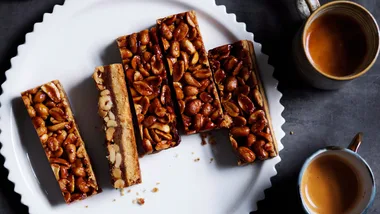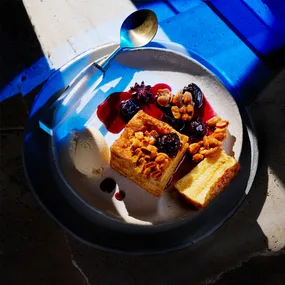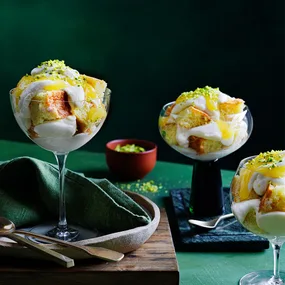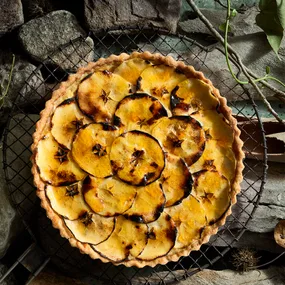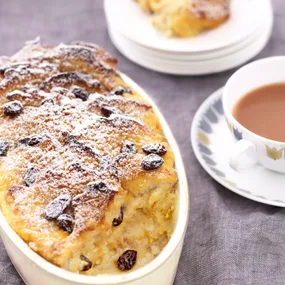The gingerbread house is one of our favourite festive foods, and while it may seem incongruous (those snow-laden eaves in our warm-weather Christmas), we say if ever there’s a reason to abandon logic and embrace whimsy and the child within, Christmas time is it.
Adjust your gingerbread spice according to taste
The spiciness of gingerbread is very much a matter of taste – some people love their gingerbread dangerously dark and very spicy, while others prefer a light golden dough with an equally light dash of spice. Ours sits somewhere in between; adjust the spice levels to suit your palate. For a darker gingerbread, use all dark muscovado sugar and replace the golden syrup with molasses. The gingerbread dough is simple and can be made up to a week in advance and refrigerated. Let it stand at room temperature to soften slightly before rolling it out on a lightly floured surface.
This is our favourite gingerbread recipe.
Use cardboard templates
The easiest way to cut out the pieces of gingerbread is to make cardboard templates as a guide. For our house we made three templates: the side walls measure 14cm high and 24cm long; the roof pieces are 10.5cm wide and 27cm long; and the end walls are 13cm wide and 14cm high, with a 6cm-high pitch for the roof. Cut out two of each piece from the dough (you may need to re-roll the scraps). We also made shutters and a Christmas tree from the scraps, but you’re limited only by your imagination in this department.

Step 1: Use cardboard templates to cut out your gingerbread house pieces.
(Photo: Dean Wilmot)Cool your gingerbread completely
Once the gingerbread pieces are baked, cool them briefly on the oven trays, then cool them completely on wire racks, ensuring they’re completely flat, and store them in airtight containers between layers of baking paper until required.
The important of piping bags
A couple of piping bags and cake decorating piping tubes are a worthy investment if you plan to make a gingerbread house. Cake decorating piping tubes are smaller than pâtisserie piping tubes, are made of metal and come in all manner of shapes to produce different decorative finishes. We found the most versatile were a 2mm plain tube and a 4mm scalloped tube, but feel free to play around. You’ll also need a board or flat platter to act as the foundations of your house – cake decorating suppliers have these, or you could use a chopping board.
The quantity of royal icing we’ve made may seem enormous, but how much you need will depend on the amount of decoration you have planned, and also upon the steadiness of your hand – a little extra leaves room for error. You may find it easier to make it in two batches, and that way you can adjust the consistency according to how you intend to use the icing – we found that a thicker consistency was better for bonding the structure together, while a slightly thinner version was more suited to decorative work. Adjust the icing with extra icing sugar or water as you go, and when piping, do a test run on a piece of baking paper before you start to ensure you’ve got the consistency you’re after.
We found it easiest to do all the decorative piping on the gingerbread pieces before assembling them, but you do need to ensure the icing is completely dry before you begin construction, and take care not to chip it while you’re building the house. Decorate the pieces with whatever edible fripperies you like – we’ve gone for a silver and white theme and used silver cachous in various sizes, but you could use any sweets you like, pressing them into the icing while it’s still wet. Don’t get too carried away, though, or your house might collapse under their weight – the principles of load-bearing walls apply to gingerbread houses too.

Step 2: It’s best to decorate the gingerbread pieces before constructing the house.
(Photo: Dean Wilmot)To keep the walls upright and perpendicular to the adjacent pieces during assembly, you’ll need to use straight-sided glasses. Ensure the walls are steady, secure and thoroughly bonded before you affix the roof – at this stage it’s fun to fill the house with lollies (avoid chocolate, though, which may melt in the summer heat).

Step 5: Use straight-sided glasses or tumblers to keep the gingerbread walls standing upright.
(Photo: Dean Wilmot)
Step 7: Ensure the walls are steady, secure and thoroughly bonded before you affix the roof.
(Photo: Dean Wilmot)The finishing touch is to disguise the board, using fondant or more royal icing to cover it. And now your work is done – at this point your creation will last for about a week. Add drifts of icing-sugar snow to complete the scene just before you serve the gingerbread. We’re dreaming of a white Christmas.

Step 8: Don’t forget your icicles, and use fondant or more royal icing to conceal the board.
(Photo: Dean Wilmot)